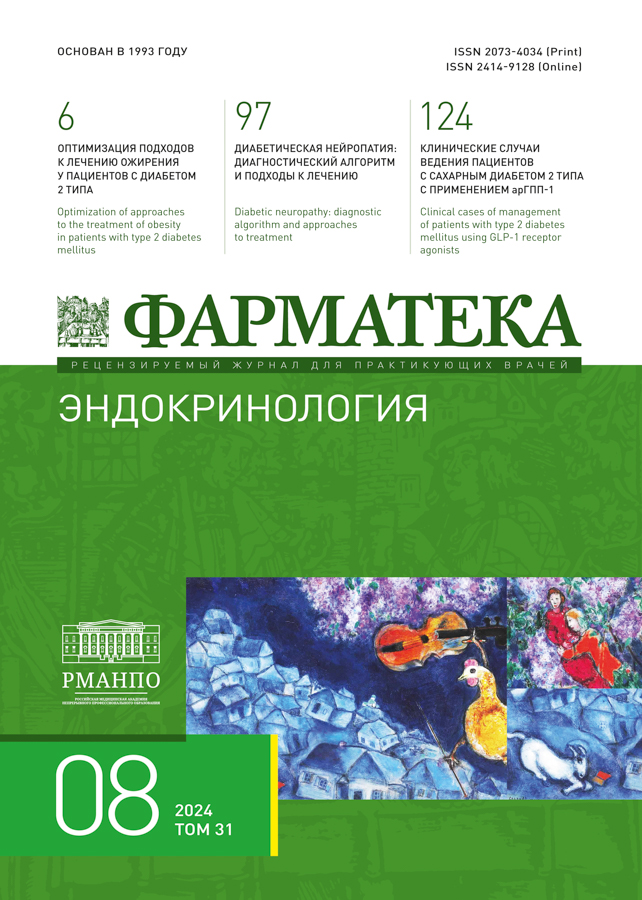Возможности применения инсулина деглудек в терапии сахарного диабета у пациентов с предшествующей неэффективной инсулинотерапией: разбор клинических случаев
- Авторы: Елсукова О.С.1,2
-
Учреждения:
- Кировский государственный медицинский университет
- Кировская клиническая больница № 7 им. В.И. Юрловой
- Выпуск: Том 31, № 8 (2024)
- Страницы: 114-123
- Раздел: Клинический разбор
- URL: https://journals.eco-vector.com/2073-4034/article/view/680287
- DOI: https://doi.org/10.18565/pharmateca.2024.8.114-123
- ID: 680287
Цитировать
Полный текст
Аннотация
Достижение и удержание целевых значений гликемического контроля остается актуальной задачей при лечении пациентов с сахарным диабетом как 1 типа (СД1), так и 2 типа (СД2). На современном этапе, помимо уровня гликированного гемоглобина, появились новые показатели контроля уровня глюкозы, связанные с внедрением метода непрерывного мониторинга глюкозы у пациентов. Особое внимание уделяют показателям вариабельности гликемии (ВГ). У пациентов с СД1 терапия инсулинами средней продолжительности действия и их аналогами, имеющими пик действия, не в полной мере имитирует эндогенную секрецию инсулина, повышает риск гипогликемии и может быть сопряжена с ростом числа случаев ВГ. Пациенты с СД2 чаще нуждаются в более высоких дозах инсулинов, применение которых также сопряжено с высокой ВГ. ВГ может быть рассмотрена как фактор риска гипогликемий и сосудистых осложнений. Появление инсулинов нового поколения с длительным действием, не имеющих пика всасывания, может обеспечить снижение ВГ. Инсулин деглудек (Тресиба®) является аналогом базального инсулина длительного действия (с продолжительностью действия более 42 часов), который специально разрабатывался для низкой вариабельности действия. В данной статье рассматривается серия клинических случаев перевода пациентов с СД1 и СД2 на терапию инсулином деглудек в связи с неэффективным предшествующим лечением инсулином детемир.
Ключевые слова
Полный текст
Об авторах
О. С. Елсукова
Кировский государственный медицинский университет; Кировская клиническая больница № 7 им. В.И. Юрловой
Автор, ответственный за переписку.
Email: oselsukova@mail.ru
ORCID iD: 0000-0002-2341-9491
к.м.н., доцент кафедры госпитальной терапии; зав. эндокринологическим отделением регионального эндокринологического центра
Россия, Киров; КировСписок литературы
- Дедов И.И., Шестакова М.В., Викулова О.К. и др. Сахарный диабет в Российской Федерации: динамика эпидемиологических показателей по данным Федерального регистра сахарного диабета за период 2010–2022 гг. Сахарный диабет. 2023;26(2):104–23. [Dedov I.I., Shestakova M.V., Vikulova O.K., et al. Diabetes mellitus in the Russian Federation: dynamics of epidemiological indicators according to the Federal Register of Diabetes Mellitus for the period 2010–2022. Diabetes Mellitus. 2023;26(2):104-23. (In Russ.)]. doi: 10.14341/DM13035.
- Алгоритмы специализированной медицинской помощи больным сахарным диабетом. Под ред. И.И. Дедова, М.В. Шестаковой, А.Ю. Майорова. 10-й выпуск, доп. Сахарный диабет. 2019;22(1 Suppl. 1):1–144. [Algorithms of specialized medical care for patients with diabetes mellitus. Edited by I. I. Dedov, M. V. Shestakova, A. Yu. 10th issue, suppl. Diabetes Mellitus. 2019;22(1 Suppl. 1):1–144. (In Russ.)].
- American Diabetes Association Professional Practice Committee. 1. Improving Care and Promoting Health in Populations: Standards of Medical Care in Diabetes – 2022. Diab Care. 2022;45(Suppl. 1):S8–16.
- Iga R., Uchino H., Kanazawa K., et al. Glycemic Variability in Type 1 Diabetes Compared with Degludec and Glargine on the Morning Injection: An Open-label Randomized Controlled Trial. Diab Ther. 2017;8(4):783–92. doi: 10.1007/s13300-017-0269-0.
- Nicolucci A., Ceriello A., Di Bartolo P., et al. Rapid-Acting Insulin Analogues Versus Regular Human Insulin: A Meta-Analysis of Effects on Glycemic Control in Patients with Diabetes. Diab Ther. 2020;11(3):573–84. doi: 10.1007/s13300-019-00732-w.
- Pal R., Banerjee M., Bhadada S.K. Glycaemic efficacy and safety of mealtime faster-acting insulin aspart administered by injection as compared to insulin aspart in people with diabetes mellitus: A meta-analysis of randomized controlled trials. Diab Med. 2021;38(3):e14515. doi: 10.1111/dme.14515.
- Monnier L., Colette C., Owens D. Glucose variability and diabetes complications: Risk factor or biomarker? Can we disentangle the “Gordian Knot”? Diab Metab. 2021;47(3):101225. doi: 10.1016/j.diabet.2021.101225.
- Sun B., Luo Z., Zhou J. Comprehensive elaboration of glycemic variability in diabetic macrovascular and microvascular complications. Cardiovasc Diab. 2021;20(1):9. doi: 10.1186/s12933-020-01200-7.
- Wilmot E.G., Choudhary P., Leelarathna L., Baxter M. Glycaemic variability: The under-recognized therapeutic target in type 1 diabetes care. Diab Obes Metab. 2019;21(12):2599–608. doi: 10.1111/dom.13842.
- Danne T., Nimri R., Battelino T., et al. International Consensus On Use Of Continuous Glucose Monitoring. Diab Care. 2017;40(12):1631–40. doi: 10.2337/Dc17-1600.
- Гариева М.А., Кондратьева Л.В., Черникова Н.А. Вариабельность гликемии у пациентов с сахарным диабетом типа 2, работающих в ночные смены. Эндокринология: Новости. Мнения. Обучение. 2019;8(2):16–24. [Garievа M.A., Kondratieva L.V., Chernikova N.A. Glycemic variability in patients with type 2 diabetes working on night shifts. Endocrinology: News, Opinions, Training. 2019;8(2):16–24. (In Russ.)]. Doi:.24411/2304-9529-2019-12002.
- Wysham C., Bhargava A., Chaykin L., et al. Effect of insulin degludec vs insulin glargine U100 on hypoglycemia in patients with type 2 diabetes. JAMA. 2017;318(1):45. doi: 10.1001/jama.2017.7117.
- Liu W., Yang X., Huang J. Efficacy and safety of insulin degludec versus insulin glargine: A systematic review and meta-analysis of fifteen clinical trials. Int J Endocrinol. 2018;2018(2):1–10. doi: 10.1155/2018/8726046.
- Ratner R.E., Gough S.C.L., Mathieu C., et al. Hypoglycaemia risk with insulin degludec compared with insulin glargine in type 2 and type 1 diabetes: a pre-planned meta-analysis of phase 3 trials. Diab Obes Metab. 2013;15(2):175–84. doi: 10.1111/dom.12032.
Дополнительные файлы



















